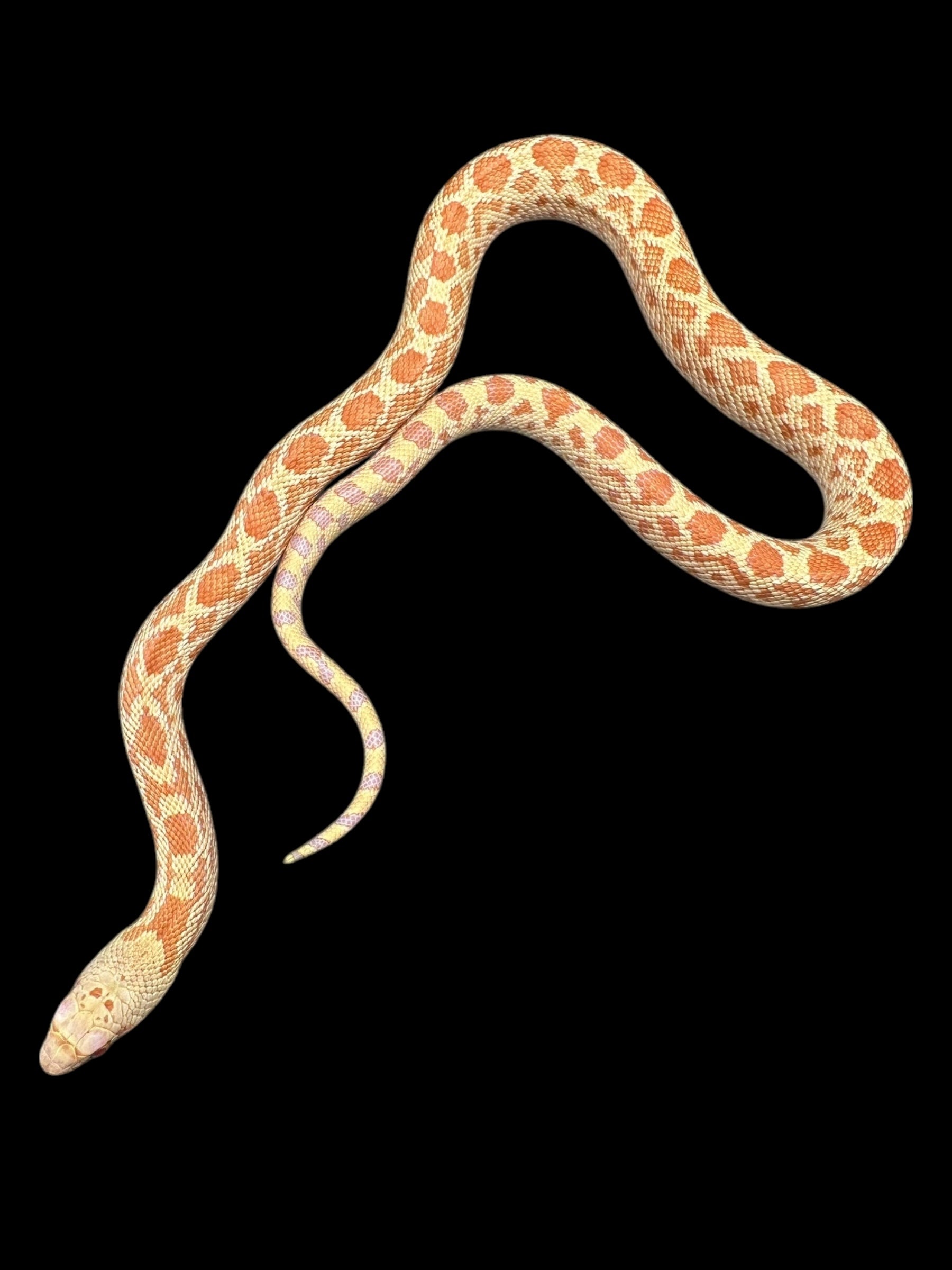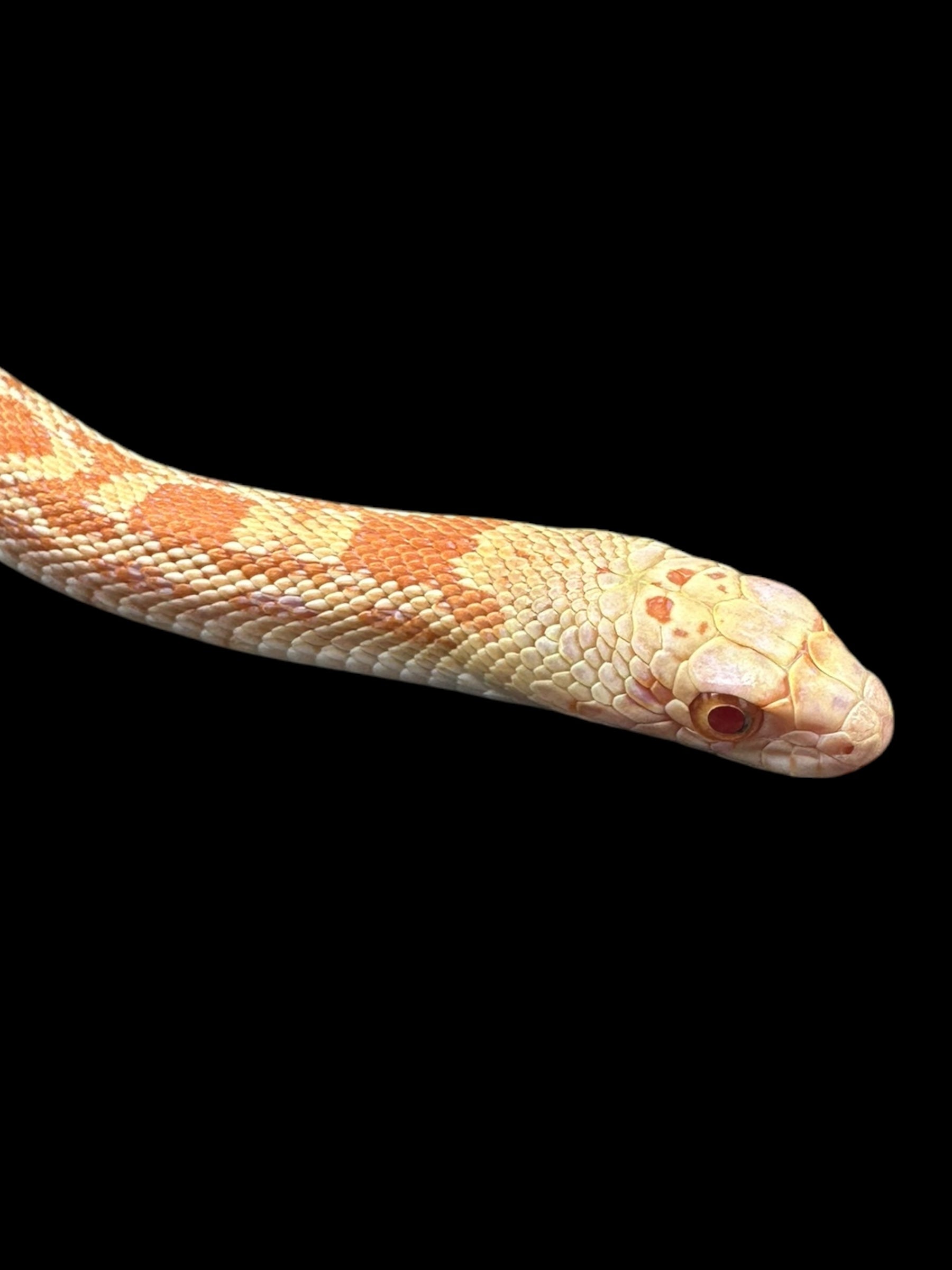Photo Disclaimer
Description
Sonoran Gopher Snake (Rusty Albino)
Scientific Name: Pituophis catenifer affinis
Common Name: Sonoran Gopher Snake
Species Overview
Size: Adult Sonoran Gopher Snakes typically reach 4–6.5 feet (1.2–2.0 m) in length; in rare cases, they may approach 7 feet (2.1 m). They are strong, medium-to-large constrictors with keeled scales, a pointed snout, and an athletic build adapted to the arid landscapes of the American Southwest.
Appearance: The Rusty Albino Sonoran Gopher Snake is a breathtaking double-recessive morph that combines the Albino and Rusty genes to produce a snake of exceptional warmth and depth of colour. The Albino gene removes all dark pigment, while the Rusty gene enriches the remaining warm pigments, creating deep golden, orange, and copper-red tones over a creamy base. The pattern remains sharp and defined, with each blotch glowing in shades of amber and burnished orange. The eyes are ruby-red, completing the morph’s fiery, desert-inspired palette. This combination enhances the Sonoran subspecies’ naturally vivid desert hues, making the Rusty Albino one of the most visually striking Pituophis morphs in existence.
Distribution: Native to the southwestern United States and northern Mexico, including regions of Arizona, New Mexico, western Texas, and the Mexican states of Sonora and Chihuahua.
Habitat: In the wild, Sonoran Gopher Snakes inhabit dry deserts, rocky scrublands, and sandy foothills. In captivity, they thrive in spacious terrestrial setups with loose substrate for burrowing, open basking zones, and secure hides.
Behaviour: Sonoran Gopher Snakes are intelligent, alert, and active constrictors. Though capable of dramatic defensive displays in the wild, captive-bred individuals are typically calm, confident, and curious when handled regularly.
Captive Care
Enclosure: Provide an enclosure at least 4 feet × 2 feet × 2 feet for adults, though larger is always beneficial. Use a dry, loose substrate such as aspen, soil-sand blend, or coconut husk mix to encourage burrowing. Include climbing branches, rocks, and multiple hides for enrichment.
Temperature & Humidity: Maintain a daytime gradient of 78–86°F (25–30°C) with a basking area near 90°F (32°C). Allow nighttime drops to 68–72°F (20–22°C). Keep humidity between 30–45%, increasing slightly during shedding periods.
Diet: Offer thawed rodents proportional to the snake’s girth—juveniles every 5–7 days and adults every 10–14 days. Rusty Albino Sonoran Gopher Snakes are reliable feeders that grow steadily with consistent husbandry.
Behaviour in Captivity: Active, intelligent, and visually striking, Rusty Albino Sonoran Gopher Snakes make excellent display animals. They are hardy and adapt quickly to handling, thriving in naturalistic setups that allow exploration and movement.
Special Considerations: As Albinos, these snakes may be more sensitive to overly bright light. Provide shaded hides and gradual lighting to minimize stress. Secure enclosure lids are essential due to the species’ strength and curiosity.
Genetics Note
Albino (Recessive): Removes all black pigmentation, revealing vivid yellows, oranges, and reds.
Rusty (Recessive): Deepens red and copper pigments, producing warm, earthy tones that intensify the Albino’s golden hues.
Rusty Albino (Double Recessive Combination): When combined, these genes produce glowing copper, amber, and cream tones with ruby-red eyes and no dark pigment.
Genetic Combination Summary
The Sonoran Gopher Snake (Rusty Albino) expresses two recessive traits:
-
Albino (Recessive): Removes dark pigmentation, exposing bright yellows and creams.
-
Rusty (Recessive): Enriches red and copper hues, intensifying overall warmth.
Together, these traits create the Rusty Albino—an elegant, flame-toned morph that radiates with desert-inspired colour. Highly sought after by collectors and breeders alike, the Rusty Albino Sonoran Gopher Snake represents the perfect fusion of natural desert vibrancy and refined morph development within Pituophis catenifer affinis.



